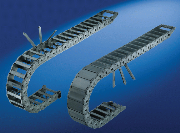 Cable carriers from Kabelschlepp are being used to route the cables used on a range of machines designed for strapping goods for secure transportation around the world
Cable carriers from Kabelschlepp are being used to route the cables used on a range of machines designed for strapping goods for secure transportation around the world
Strapping is essential to ensure goods are safely and securely transported around the world, and to meet such requirements, Germany-based TITAN Umreifungstechnik specialises in systems for this task. As a result, packages from the metal, steel and wood processing, fabric and building material industries are packaged using solutions from the company, as well as other products including bottles and cans.
The company’s special machines and systems business sector specialises in customer-specific, fully-automatic strapping systems, and at the end of the production lines its systems ensure that the products are optimally secured for worldwide shipment. This is attained by strapping using belts made from synthetic material or metal, which provide secure fixing of the freight for transportation by lorry, ship or rail.
One example is its systems for packaging split-strip coils made from metals such as steel or copper.
 A secure solution
A secure solution
Split-strip coils are manufactured from coils produced in rolling mills weighing up to 40 tons, and are then separated into smaller coils in longitudinal slitting lines for easier processing. These are further processed by the customer where they are made into springs, screws or other metallic components. Weighing many tons, the split belts are transported individually or as packages on pallets.
To secure these for transportation, they pass through two strapping systems from TITAN, with the split-strip rings initially being bound externally around the circumference and subsequently through the coil eye with several steel belts. This ensures that they do not draw out into a funnel shape during later handling.
The primary task, binding, is carried out by a strapping unit which is flexibly mounted on a boom. In addition to the strapping, this unit also carries out the sealing of the installed ‘rings’ made from synthetic material or steel belt. Steel belt is used in the packaging system for split-belt rings and is securely welded using the TITANARG sealing technology developed by TITAN. The WIG welding technique, with a Wolfram electrode and inert gas, is used for this technology.
Carrying cables
In addition to the cable for the drive motors, the strapping unit must also be supplied with the inert gas for the integrated welding unit. So, the cable and gas hoses are routed together in Tsubaki Kabelschlepp Type S 0950 and S 0650 cable carriers. The length, width and precise design of the cable carriers vary from system to system as each machine is constructed for specific customer requirements.
Jörg Wonneberg, manager of mechanical engineering, is responsible for construction and project development in the sector special machines at TITAN. He said: “Because of the rough operating environments in which many of our machines are used for the surface treatment of steel in the hot area of steelworks, or in the concrete block industry, we primarily use cable carriers made from steel. But, synthetic material cable carriers are sometimes used.”
Kabelschlepp’s steel cable carriers have been especially developed for large self-supporting lengths with high mechanical loads or weights, but are also useful where the application faces rough conditions, as is common for the strapping machines from TITAN. High ambient temperatures, as in metal and steel processing, or extreme environmental influences by dust and contamination, such as in the concrete block industry, present no problems for the durable S-series steel cable carrier.
The carriers are manufactured from galvanized steel or, for specific requirements, from stainless steel. Usually they are equipped with stays made from aluminium, which can be precisely adapted to the application in 1mm increments. The stays assume two primary tasks – they form the mechanical connection between the chain belts and are the direct contact and friction points with the cables that are transported in the cable carriers. Thus their friction coefficient has a significant influence on the service life of the cables and reliability of the complete cable carrier system.
Depending on the application and its loads, Tsubaki Kabelschlepp offers different stay variants, made from an aluminium alloy. The stay variant RS 1, with a quick-release profile rod outside or inside and RS 2, with bolted profile rods, can be combined with all steel-made cable carriers. For heavy demands, there is the Type RV, an aluminium frame stay in reinforced design.
The stay variant RM is a solid version whereby the profile rods are double bolted, which provides maximum stability as required for especially heavy loads or large chain widths. If larger cable diameters must be transported, for example air lines, the company offers the RMA mounting frame stay. Available in sizes of 130, 160 or 200mm, these can be installed inside or outside.
A variant for transporting cables are the LG Type hole stays. The hole stays are manufactured application specific to clamp number, diameter and positions of all cables across the carrier. The result is a perfect run of cables in the neutral bending zone. This has the advantage that the relative movement between cables and stay is minimised – ensuring optimum transporting.
Protection from objects entering the carrier and damaging cables is provided by enclosed cable carriers. The stay variant Type RMD has, for example, been developed for this purpose. This has a hinged and openable and detachable protective cover on both sides, made from aluminium. The range is completed by the RR stay variant, which uses rollers as a connection profile. The material used for the axes and tubes can be adapted to the application.
Kabelschlepp

